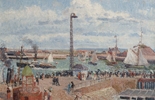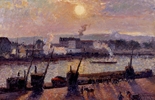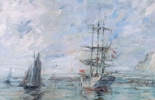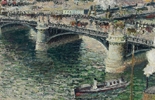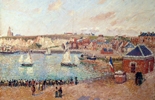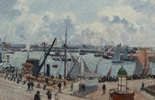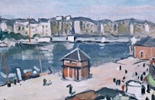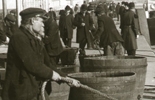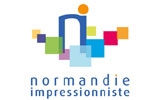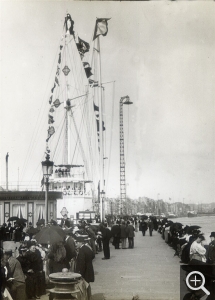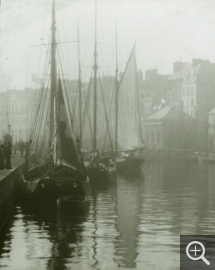Pissarro dans les ports
from April 27 to September 29, 2013
Between 1883 and 1903, when Camille Pissarro was visiting and painting the ports of Rouen, Dieppe and Le Havre, photography was no longer confined to pioneers, but was expanding into new markets, including the thriving sector of tourist photography.
Pissarro was working in a context in which photographs were becoming more and more prevalent. He himself was interested in photography and tried his hand at it, as can be seen from the recently discovered family album, exhibited for the first time.
Tourist photographs were taken both by professional photographers, who gradually moved over from collodion* to postcards (Emile Letellier, the Neurdein brothers, and so on), and by amateurs who used gelatin silver** and organized projection sessions.
Offering fairly standardised views of the Norman ports (whose subjects include the outer harbours of Le Havre and Dieppe and the banks of the Seine in Rouen), the professionals gradually abandoned static pictures of monuments in favour of livelier harbour scenes and landscapes. In Le Havre,the brothers Macaire and Warnod had paved the way, with their photographs taken from the north jetty. Ships in full sail and liners trailing smoke with semaphores or breakwaters in the background in Le Havre, the ballet of ferries and fishing-boats in the outer harbour at Dieppe, or goods lined up in front of façades on the quays in Rouen, became popular subjects that attracted a clientèle of travellers and tourists.
From the 1880s onwards, amateur photographers, many of whom belonged to photographic societies like the ones operating in Le Havre and Rouen around 1890, organised outings and sporting activities. The ports of Rouen, Dieppe and Le Havre were among their favourite subjects. Alfred Soclet, who documented local life; Louis Chesneau, the forefather of photo-reportage; and Robert Demachy, who took artistic, pictorial photographs, were among the amateur photographers who shared their collections of plates at projection sessions held by photography clubs for the purpose of education or entertainment.
Tourism was the link between all these photographs. The presentation here, in the form of a documentary wall and a projection, provides an opportunity to see this sizeable but as yet little-known body of work, using Pissarro's presence as a leitmotiv.
Tourist photographs were taken both by professional photographers, who gradually moved over from collodion* to postcards (Emile Letellier, the Neurdein brothers, and so on), and by amateurs who used gelatin silver** and organized projection sessions.
Offering fairly standardised views of the Norman ports (whose subjects include the outer harbours of Le Havre and Dieppe and the banks of the Seine in Rouen), the professionals gradually abandoned static pictures of monuments in favour of livelier harbour scenes and landscapes. In Le Havre,the brothers Macaire and Warnod had paved the way, with their photographs taken from the north jetty. Ships in full sail and liners trailing smoke with semaphores or breakwaters in the background in Le Havre, the ballet of ferries and fishing-boats in the outer harbour at Dieppe, or goods lined up in front of façades on the quays in Rouen, became popular subjects that attracted a clientèle of travellers and tourists.
From the 1880s onwards, amateur photographers, many of whom belonged to photographic societies like the ones operating in Le Havre and Rouen around 1890, organised outings and sporting activities. The ports of Rouen, Dieppe and Le Havre were among their favourite subjects. Alfred Soclet, who documented local life; Louis Chesneau, the forefather of photo-reportage; and Robert Demachy, who took artistic, pictorial photographs, were among the amateur photographers who shared their collections of plates at projection sessions held by photography clubs for the purpose of education or entertainment.
Tourism was the link between all these photographs. The presentation here, in the form of a documentary wall and a projection, provides an opportunity to see this sizeable but as yet little-known body of work, using Pissarro's presence as a leitmotiv.
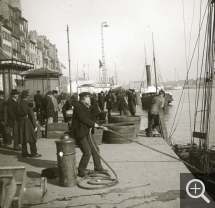
Alfred SOCLET (1853-1926), The Grand Quai, projection slide, 8.5 x 10 cm. Le Havre, Centre havrais de recherche historique (CHRH). © CHRH / Alfred Soclet
*The collodion wet plate process was invented in 1851 and made it possible to take a photograph at a fast speed (for the time), with excellent definition. Its drawback was that the material lost all sensitivity once dry, so has to be used and developed very quickly.
**The gelatin silver dry plate process. Unlike with collodion, the gelatin's hygroscopic qualities meant the glass plates could be prepared in advance, a considerable time before the photograph was taken, and then processed in a laboratory. This signalled the beginning of "instant" photography.
**The gelatin silver dry plate process. Unlike with collodion, the gelatin's hygroscopic qualities meant the glass plates could be prepared in advance, a considerable time before the photograph was taken, and then processed in a laboratory. This signalled the beginning of "instant" photography.


